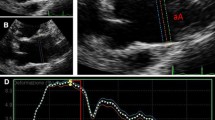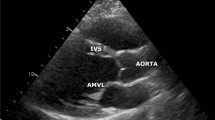Abstract
The aim of this study was to measure, characterize, and compare the time-resolved three-dimensional wall kinematics of the ascending and the abdominal aorta. Comprehensive description of aortic wall kinematics is an important issue for understanding its physiological functioning and early detection of adverse changes. Data on the three-dimensional, dynamic cyclic deformation of the aorta in vivo are scarce. Either most imaging techniques available are too slow to capture aortic wall motion (CT, MRI) or they do not provide three-dimensional geometry data. Three-dimensional volume data sets of ascending and abdominal aortae of male healthy subjects (25.5 [24.5, 27.5] years) were acquired by use of a commercial echocardiography system with a temporal resolution of 11–25 Hz. Longitudinal and circumferential strain, twist, and relative volume change were determined by use of a commercial speckle tracking algorithm and in-house software. The kinematics of the abdominal aorta is characterized by diameter change, almost constant length and unidirectional, either clockwise or counter clockwise twist. In contrast, the ascending aorta undergoes a complex deformation with alternating clockwise and counterclockwise twist. Length and diameter changes were in the same order of magnitude with a phase shift between both. Longitudinal strain and its phase shift to circumferential strain contribute to the proximal aorta’s Windkessel function. Complex cyclic deformations are known to be highly fatiguing. This may account for increased degradation of components of the aortic wall and therefore promote aortic dissection or aneurysm formation.












Similar content being viewed by others
References
Astrand H, Stalhand J, Karlsson J, Karlsson M, Sonesson B, Lanne T (2011) In vivo estimation of the contribution of elastin and collagen to the mechanical properties in the human abdominal aorta: effect of age and sex. J Appl Physiol 110(1):176–187
Bell V, Mitchell WA, Sigurethsson S, Westenberg JJM, Gotal JD, Torjesen AA, Aspelund T, Launer LJ, de Roos A, Gudnason V, Harris TB, Mitchell GF (2014) Longitudinal and circumferential strain of the proximal aorta. J Am Heart Assoc 3(6):e001536
Bell V, Sigurdsson S, Westenberg JJM, Gotal JD, Torjesen AA, Aspelund T, Launer LJ, Harris TB, Gudnason V, de Roos A, Mitchell GF (2015) Relations between aortic stiffness and left ventricular structure and function in older participants in the age, gene/environment susceptibility-reykjavik study. Circ Cardiovasc Imaging 8(4):e003039
Beller CJ, Labrosse MR, Thubrikar MJ, Robicsek F (2004) Role of aortic root motion in the pathogenesis of aortic dissection. Circulation 109(6):763–769
Bellhouse BJ, Bellhouse FH (1968) Mechanism of closure of the aortic valve. Nature 217(5123):86–87
Bihari P, Shelke A, Nwe T, Mularczyk M, Nelson K, Schmandra T, Knez P, Schmitz-Rixen T (2013) Strain measurement of abdominal aortic aneurysm with real-time 3D-ultrasound speckle tracking. Eur J Vasc Endovasc Surg 45(4):315–323
Buckberg GD, Hoffman JIE, Coghlan HC, Nanda NC (2015) Ventricular structure-function relations in health and disease: part I. The normal heart. Eur J Cardiothorac Surg 47(4):587–601
Carlsson M, Cain P, Holmqvist C, Stahlberg F, Lundback S, Arheden H (2004) Total heart volume variation throughout the cardiac cycle in humans. Am J Physiol-Heart Circ Physiol 287(1):H243–H250
Dagum P, Green GR, Nistal FJ, Daughters GT, Timek TA, Foppiano LE, Bolger AF, Ingels NB Jr, Miller DC (1999) Deformational dynamics of the aortic root: modes and physiologic determinants. Circulation 100(Suppl II):II54–II62
Derwich W, Wittek A, Pfister K, Nelson K, Bereiter-Hahn J, Fritzen CP, Blase C, Schmitz-Rixen T (2015) High resolution strain analysis comparing aorta and abdominal aortic aneurysm with real time three dimensional speckle tracking ultrasound. Eur J Vasc Endovasc Surg. doi:10.1016/j.ejvs.2015.07.042
Flamini V, DeAnda A, Griffith BE (2015) Immersed boundary-finite element model of fluid-structure interaction in the aortic root. Theor Comput Fluid Dyn. doi:10.1007/s00162-015-0374-5
Griffith BE (2012) Immersed boundary model of aortic heart valve dynamics with physiological driving and loading conditions. Int J Numer Method Biomed Eng 28(3):317–345
Han HC, Fung YC (1995) Longitudinal strain of canine and porcine aortas. J Biomech 28(5):637–641
Hickson SS, Butlin M, Graves M, Taviani V, Avolio AP, McEniery CM, Wilkinson IB (2010) The relationship of age with regional aortic stiffness and diameter. JACC Cardiovasc Imaging 3(12):1247–1255
Hoffman EA, Ritman EL (1985) Invariant total heart volume in the intact thorax. Am J Physiol-Heart Circ Physiol 249(4):H883–H890
Horný L, Netušil M, Voňavková T (2014) Axial prestretch and circumferential distensibility in biomechanics of abdominal aorta. Biomech Model Mechanobiol 13(4):783–799
Humphrey JD (2002) Cardiovascular solid mechanics: cells, tissues, and organs. Springer, New York
Karatolios K, Wittek A, Nwe TH, Bihari P, Shelke A, Josef D, Schmitz-Rixen T, Geks J, Maisch B, Blase C, Moosdorf R, Vogt S (2013) Method for aortic wall strain measurement with three-dimensional ultrasound speckle tracking and fitted finite element analysis. Ann Thorac Surg 96(5):1664–1671
Kok AM, Nguyen VL, Speelman L, Brands PJ, Schurink GH, van de Vosse FN, Lopata RGP (2015) On the feasibility of wall stress analysis of abdominal aortic aneurysms using three-dimensional ultrasound. J Vasc Surg 61(5):1175–1184
Kozerke S, Scheidegger MB, Pedersen EM, Boesiger P (1999) Heart motion adapted cine phase-contrast flow measurements through the aortic valve. Magn Reson Med 42(5):970–978
Lundback S (1986) Cardiac pumping and function of the ventricular septum. Acta Physiol Scand Suppl 550:1–101
Maksuti E, Bjallmark A, Broome M (2015) Modelling the heart with the atrioventricular plane as a piston unit. Med Eng Phys 37(1):87–92
Martin C, Sun W, Primiano C, McKay R, Elefteriades J (2013) Age-dependent ascending aorta mechanics assessed through multiphase CT. Ann Biomed Eng 41(12):2565–2574
Mercer JL (1969) Movement of the aortic annulus. Br J Radiol 42(500):623–626
Meunier J (1998) Tissue motion assessment from 3D echographic speckle tracking. Phys Med Biol 43(5):1241–1254
Morrison T, Choi G, Zarins C, Taylor C (2009) Circumferential and longitudinal cyclic strain of the human thoracic aorta: age-related changes. J Vasc Surg 49(4):1029–1036
Nichols WW, O’Rourke MF, Vlachopoulos C, McDonald DA (2011) McDonald’s blood flow in arteries: theoretical, experimental and clinical principles, 6th edn. Hodder Arnold, London
Ogden RW (1997) Non-linear elastic deformations. Dover books on physics, Dover, Mineola
O’Rourke MF (2007) Arterial aging: pathophysiological principles. Vasc Med 12(4):329–341
O’Rourke MF, Staessen JA, Vlachopoulos C, Duprez D, Plante GE (2002) Clinical applications of arterial stiffness; definitions and reference values. Am J Hypertens 15(5):426–444
Park J, Choi Y, Shin J, Yang H, Lim H, Choi B, Choi S, Yoon M, Hwang G, Tahk S, Shin J (2011) Validation of three-dimensional echocardiography for quantification of aortic root geometry: comparison with multi-detector computed tomography. J Cardiovasc Ultrasound 19(3):128–133
Schulze-Bauer C, Morth C, Holzapfel G (2003) Passive biaxial mechanical response of aged human iliac arteries. J Biomech Eng-T ASME 125(3):395–406
Sengupta PP, Tajik AJ, Chandrasekaran K, Khandheria BK (2008) Twist mechanics of the left ventricle: principles and application. JACC Cardiovasc Imaging 1(3):366–376
Seo Y, Ishizu T, Enomoto Y, Sugimori H, Yamamoto M, Machino T, Kawamura R, Aonuma K (2009) Validation of 3-dimensional speckle tracking imaging to quantify regional myocardial deformation. Circulation 2(6):451–459
Soliman OII, Kirschbaum SW, van Dalen BM, van der Zwaan HB, Mahdavian Delavary B, Vletter WB, van Geuns RM, ten Cate FJ, Geleijnse ML (2008) Accuracy and reproducibility of quantitation of left ventricular function by real-time three-dimensional echocardiography versus cardiac magnetic resonance. Am J Cardiol 102(6):778–783
Weber TF, Muller T, Biesdorf A, Worz S, Rengier F, Heye T, Holland-Letz T, Rohr K, Kauczor H, von Tengg-Kobligk H (2014) True four-dimensional analysis of thoracic aortic displacement and distension using model-based segmentation of computed tomography angiography. Int J Cardiovas Imaging 30(1):185–194
Wittek A, Derwich W, Karatolios K, Fritzen CP, Vogt S, Schmitz-Rixen T, Blase C (2015) A finite element updating approach for identification of the anisotropic hyperelastic properties of normal and diseased aortic walls from 4D ultrasound strain imaging. J Mech Behav Biomed Mater. doi:10.1016/j.jmbbm.2015.09.022
Acknowledgments
The authors wish to thank W. Gorissen and M. Zahn from Toshiba Medical Systems\(^{\mathrm{TM}}\) Europe, for technical assistance with the wall motion tracking algorithm.
Author information
Authors and Affiliations
Corresponding author
Ethics declarations
Conflict of interest
The authors declare that they have no conflict of interest.
Funding
The funding of this work by the Adolf Messer foundation and the LOEWE program PreBionics of the ministry of higher education, research, and the arts (HMWK, Hesse, Germany) is gratefully acknowledged.
Additional information
Andreas Wittek and Konstantinos Karatolios have contributed equally to this work.
Rights and permissions
About this article
Cite this article
Wittek, A., Karatolios, K., Fritzen, CP. et al. Cyclic three-dimensional wall motion of the human ascending and abdominal aorta characterized by time-resolved three-dimensional ultrasound speckle tracking. Biomech Model Mechanobiol 15, 1375–1388 (2016). https://doi.org/10.1007/s10237-016-0769-2
Received:
Accepted:
Published:
Issue Date:
DOI: https://doi.org/10.1007/s10237-016-0769-2




